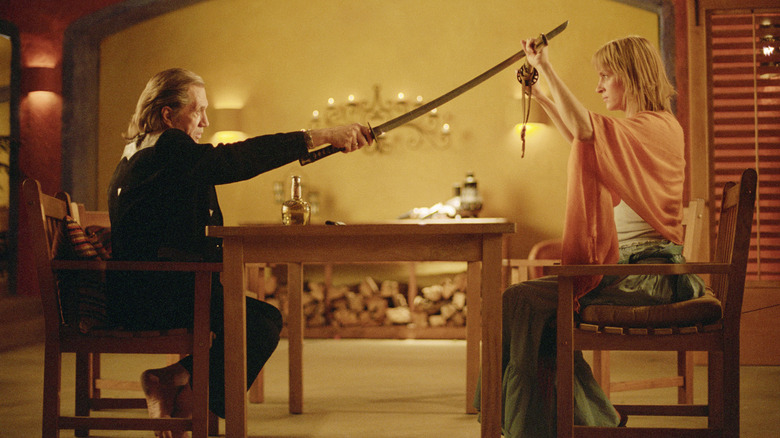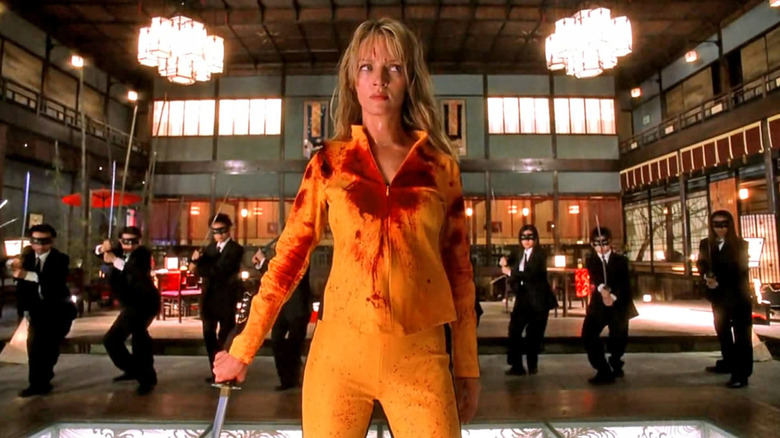If Kill Bill Had Been Just One Film, Quentin Tarantino Knows What He'd Cut
My favorite thing about Quentin Tarantino's "Kill Bill" is that it's an epic hero's journey, and, thus, a two-part tale. It's a jam-packed story and naturally lends itself to stretching out into multiple films — way before doing so was not only a thing, but an expectation. After all, "Kill Bill," though completely different in content and style, came before the double finales of the "Harry Potter" or "The Hunger Games" films.
Despite how well "Kill Bill" works as a two-part endeavor, Tarantino does have an idea of which scenes he would cut if the story had been shrunken down into a 3-hour picture. In 2012, he told IGN (in an interview with The Bride herself, Uma Thurman):
"The Esteban Vallejo scene wouldn't be in the movie. If you're trying to tell your story in three hours or so, you don't need that scene. I think that's one of the most mesmerizing scenes in the movie. The anime scene that everyone likes, whoop!, it would have been just enough to get the point across. If I had to lose anything it would have been that. You always have to make those kind of choices like that."
The scene in question is actually the only one I myself think would be best to cut. I agree with Tarantino here, it's not entirely necessary, despite being as "mesmerizing" as it is. And it is mesmerizing, and the late Michael Parks is a total chameleon as Vallejo. In general, though, the scene opened a culture can of worms definitely worth addressing, but which could've been avoided with racially sensitive casting. It does give us worthwhile information for Beatrix Kiddo's quest, but like the writer-director said, the anime sequence — which comes as the most pleasant of surprises — suffices for the information we need about Bill's transgressions.
The hero's journey, condensed
Tarantino, who made the "Kill Bill" saga as his fourth and fifth films, also noted he would tweak even more of his story if necessary to condense it to one movie:
"The Pei Mai scene would have shrunk dramatically. Now I'm talking about scenes that are some of the best scenes in the movie, but in this hurdling pace where you're trying to tell only one story, that would have been the stuff that would have had to go. But to me, that's kind of what the movie was, these little detours and these little grace notes."
Here's where Tarantino and I differ in opinion. The Pei Mai scene is a crucial part of The Bride's hero's journey — a widely used "monomyth" storytelling structure broken down by Joseph Campbell in his 1990 book "The Hero's Journey" — falling under the act one section of "separation." According to Campbell's 12-step structure, there are four sections during which different stages of the journey occur. The first is "separation," where the hero has to acknowledge their quest, separate from the normal world, and dive into their destiny. During that section, there are a series of "trials and tests" leading up to their first major obstacle. Naturally, in Beatrix's case, those trials and tests all lie within her time studying with Pei Mai, a masterful samurai trainer.
Yes, the scene is long, and in a way it does remove us from the events at hand — you know, the killing of Bill. But what it gifts us in context is a major asset to the rest of the story, and ultimately, The Bride's final night with Bill. Maybe it could've been cut down drastically, but the film's core would have suffered, and ultimately maybe not been as strong. Fortunately, we got this two-parter exactly as intended.

